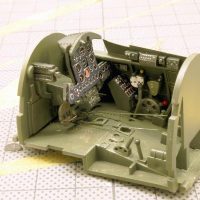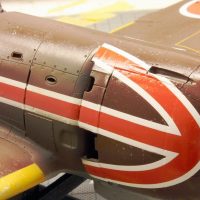Takanos last flight: Ki-84 Hayate, 57th Shinbu Tai
"The day of my sortie finally has come..." Thus begins the touching last letter of 19-year-old Megumu Takanos, which he is writing to his parents on the day of his suicide mission. It is the morning of 25 May 1945 and Corporal Takano will die during this mission in the sea area west of Okinawa. His unit, the 57th Shinbu Tai, is equipped at this time with Japan's best fighter plane, "a cutting-edge Hayate fighter", as Takano himself describes it in the letter.
The Ki-84 Hayate
In March 1943 Nakajima's new design was flown for the first time, the following month the first series production Ki-84 aircraft were delivered. The Hayate's outstanding performance was demonstrated in operational tests until October of that year, when selected front squadrons were immediately equipped. Soon the Ki-84 was considered to be the first prototype that could meet the newest allied fighters on eye level or even prove superior to them. The agile and powerful Japanese fighter quickly gained respect among the ranks of the enemy pilots. So, what made the Ki-84 Hayate such a superior design?
Already in the invitation to tender it was demanded that the planned successor of the Ki-43 Hayabusa should combine the agility and speed of its predecessor with increased firepower and- this was new in Japanese fighter planes- contemporary armour. For this purpose a powerful Nakajima Ha-45 Homare radial engine was installed, which in its last version could deliver an impressive 1926 hp.
A further innovation was found in the form of a truly powerful armament with two 20mm cannons, which were supplemented either by two 12.7mm machine guns, two additional 20mm guns or even two 30mm Ho-105 cannons. Aerodynamically efficiently designed and comparatively light in weight, the Ki-84 combined speed and firepower comparable to the latest Allied aircraft with superior manoeuvrability.
The Hayate was first used during the battles in the Gulf of Leyte. From then on, the model was present at all the scenes of the Pacific War. The Ki-84 excelled in home defence, as well as in escorting and attacking ground targets. The Ki-84 was one of the few Japanese designs that could reach and effectively engage high-flying B-29 bombers.
However, the Hayate, known as the "Frank" by the Allies, had an Achilles' heel which limited its potential and was to lead to numerous accidents. Japan's desperate supply situation led to ongoing problems with high-quality steel, and the required standards were often not met. Furthermore, errors in production became apparent. The consequences were either failures due to technical reasons or breakage due to landing gear legs buckling during take-off or landing.
The steadily declining level of training for young pilots, who were increasingly rushed through a shortened flying training programme, also prevented the Hayate from achieving its superior potential in the field. Although constructively well balanced in all parameters, the Ki-84 was a "hot" high performance fighter, which quickly overstrained insufficiently trained pilots.
A test flight shortly after the war should reveal quite clearly another reason why the Ki-84 often had to be flown below its true value: in the last months of the war there was hardly any aviation fuel with a high octane number available in Japan. In 1946, when a Ki-84 filled with AvGas 92 was flown to its limits in the United States, the most remarkable and impressive performance data was achieved. 687 Km/h was measured as the maximum speed, this is in sharp contrast to the 624 Km/h which, according to Japanese information, could be reached with the aviation fuel available at the time.
However, all this should no longer have any meaning for Corporal Takano. His unit, the 57th Shinbu Tai, was an equivalent to the Kamikaze units of the naval aviators, set up by the army aviators. Shinbu Tais" were "Special Attack Units", a euphemism that disguised the commitment to suicide missions. If you would like to know more about the letters and details described at the beginning, you can find the source under the following link: http://www.kamikazeimages.net/writings/takano/index.htm
My model shows the plane Megumu Takanos at the time of his last flight. The group was stationed in Shimodate north of Tokyo in May 1945.
To the building
It is not without reason that the Hasegawa kit has an excellent reputation. Excellent fitting accuracy, good detailing in the essential areas and a constructive approach that promises uncomplicated and speedy construction quickly capture the model maker's attention.
The markings of the model are taken from the decal sheet "Imperial Hayate Part II" by Eagle Strike. Although the large decal sheets with their rounded edges have instilled me with respect, the actual application of the markings was done quite quickly and without any problems. One secret is surely to cut the big decals, which are the two stylized arrows on the sides of the fuselage, into small portions in time. The handling of these manageable parts is then much easier than placing large, coherent pieces.
In spite of this description, especially the placement of the tripartite arrowhead was tricky: here the decals had to be softened with a lot of decal-chemistry, the decals had to be softened and then carefully and with a certain amount of perseverance nestled to the contours. The high quality and strength of Eagle Strike decals shows that this was successful.
This is now my third model from these kits - and still Hasegawa's offer of a Ki-84 Hayate on a large scale can inspire me. If you are looking for an uncomplicated and yet high quality model making pleasure, you will surely find it here!





















Hi Roland!
I kept on looking at your pics in detail and was deeply amazed by the quality of your work: cockpit, engine, painting, decalling and weathering are among the main areas that caught my eye and kept on studying your pics in amazement.
Well done!
A very fine looking Hayate, Roland.
Like Spiros, I have to say that detailing, painting, weathering and everything else is of high quality.
Love this scheme. Great work!
Wow - that one is a stunner! I want to replicate that scheme at 1/72 - how did you achieve the brown color? Beautiful model - love the finish and weathering work.
Greg, thank you for this kind reply! Gunze H-17 Cocoa Brown has been sprayed on the Alclad "primer"
Danke, Roland! I was about to ask the same question as Greg.
Beautiful model, the decals really set it off, but what a sad background story.
Hasegawa's 1/48 Hayate is definitely one of their best. So good that it's an "ace maker." Follow the instructions and you will have a great model. As Roland demonstrates.
Great colour scheme to go with your usual high standard of finish.
Thank you very much for these pleasant comments and your interest! Quite motivating!